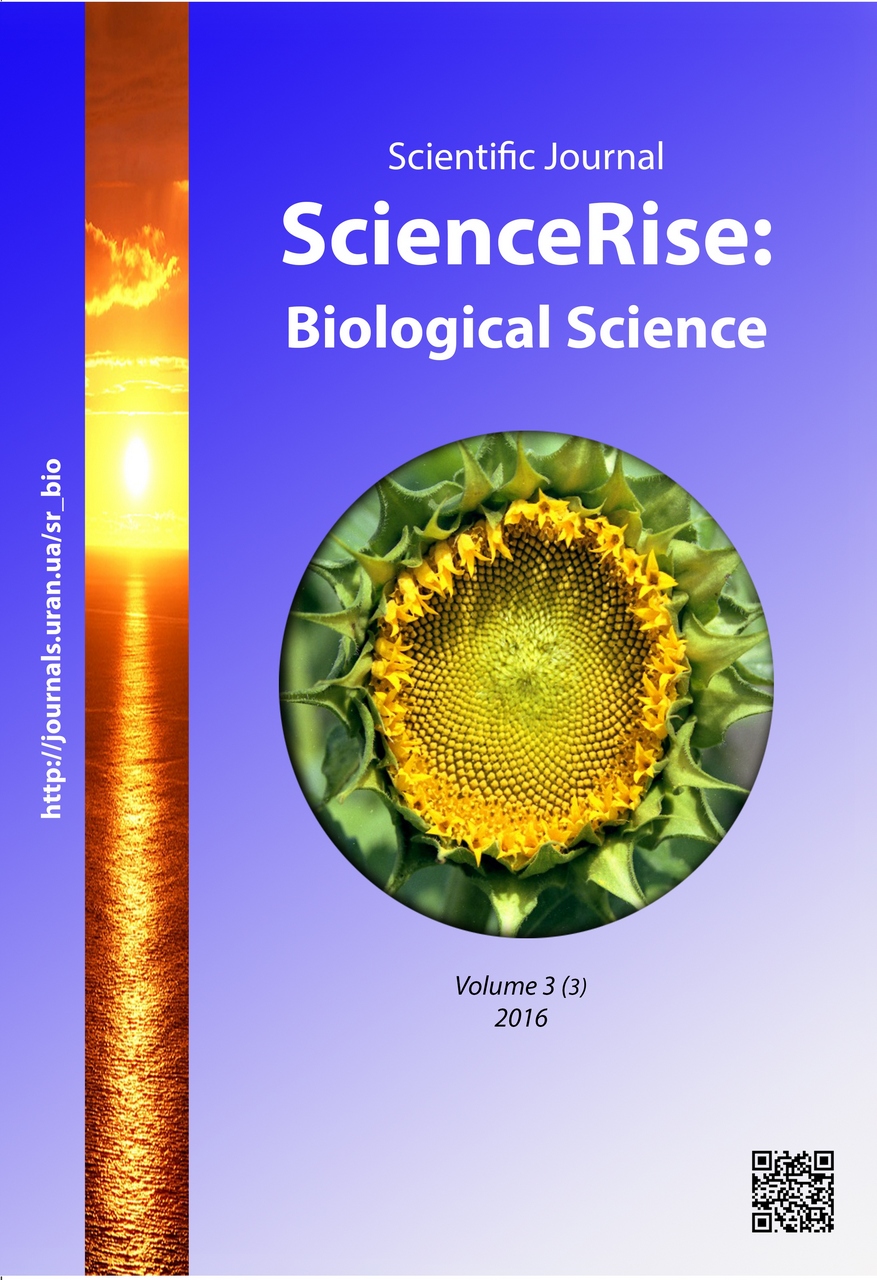Glutathione system in gastric mucosa cells under experimental consumption of increased NaCl quantity
DOI:
https://doi.org/10.15587/2519-8025.2016.83706Keywords:
glutathione, glutathione reductase, glucose-6-phosphate dehydrogenase, gastric mucosa, sodium chlorideAbstract
The glutathione system functioning features in gastric mucosa cells under experimental consumption of increased NaCl amount were considered. The prevalence of oxidative state and decreased glutathione reductase activity were found both during the impact of this factor and its two-week cancellation that might have been indicating a long-term effect on cellular metabolism
References
- Palli, D. (2000). Epidemiology of gastric cancer: an evaluation of available evidence. Journal of Gastroenterology, 35, 84–89.
- Wang, X.-Q, Terry, P. D., Yan, H. (2009). Review of salt consumption and stomach cancer risk: Epidemiological and biological evidence. World Journal of Gastroenterology, 15 (18), 2204–2213. doi: 10.3748/wjg.15.2204
- Kim, H. J., Lim, S. Y., Lee, J.-S., Park, S., Shin, A., Choi, B. Y. et. al. (2010). Fresh and pickled vegetable consumption and gastric cancer in Japanese and Korean populations: A meta-analysis of observational studies. Cancer Science, 101 (2), 508–516. doi: 10.1111/j.1349-7006.2009.01374.x
- Takahashi, M., Hasegawa, R. (1985). Enhancing effects of dietary salt on both initiation and promotion stages of rat gastric carcinogenesis. Princess Takamatsu Symposia, 16, 169–182.
- Takahashi, M., Nishikawa, A., Furukawa, F., Enami, T., Hasegawa, T., Hayashi, Y. (1994). Dose-dependent promoting effects of sodium chloride (NaCl) on rat glandular stomach carcinogenesis initiated with N-methyl-N’-nitro-N-nitrosoguanidine. Carcinogenesis, 15 (7), 1429–1432. doi: 10.1093/carcin/15.7.1429
- Furihata, C., Ohta, H., Katsuyama, T. (1996). Cause and effect between concentration-dependent tissue damage and temporary cell proliferation in rat stomach mucosa by NaCl, a stomach tumor promoter. Carcinogenesis, 17 (3), 401–406. doi: 10.1093/carcin/17.3.401
- Charnley, G., Tannenbaum, S. R. (1985). Flow cytometric analysis of the effect of sodium chloride on gastric cancer risk in the rat. Cancer Research, 45 (11), 5608–5616.
- Tsugane, S., Sasazuki, S. (2007). Diet and the risk of gastric cancer: review of epidemiological evidence. Gastric Cancer, 10 (2), 75–83. doi: 10.1007/s10120-007-0420-0
- Nozaki, K., Tsukamoto, T., Tatematsu, M. (2003). Effect of high salt diet and Helicobacter pylori infection on gastric carcinogenesis. Nihon Rinsho, 61, 36–40.
- Ballatori, N., Krance, S. M., Notenboom, S., Shi, S., Tieu, K., Hammond, C. L. (2009). Glutathione dysregulation and the etiology and progression of human diseases. Biological Chemistry, 390 (3). doi: 10.1515/bc.2009.033
- Hammond, C. L., Lee, T. K., Ballatori, N. (2001). Novel roles for glutathione in gene expression, cell death, and membrane transport of organic solutes. Journal of Hepatology, 34 (6), 946–954. doi: 10.1016/s0168-8278(01)00037-x
- Tairov, M. M., Bersimbay, R. I., Argutinsky, S. V., Salganik, R. I. (1983). Cellular localization of stimulated by histamine adenylate cyclases in gastric mucosa of rats and their role in gastric secretion regulation. Biochemistry, 48 (6), 1035–1041.
- Hissin, P. J., Hilf, R. (1976). A fluorometric method for determination of oxidized and reduced glutathione in tissues. Analytical Biochemistry, 74 (1), 214–226. doi: 10.1016/0003-2697(76)90326-2
- Mokrasch, L. C., Teschke, E. J. (1984). Glutathione content of cultured cells and rodent brain regions: A specific fluorometric assay. Analytical Biochemistry, 140 (2), 506–509. doi: 10.1016/0003-2697(84)90201-x
- Vlasova, S. N., Shabunina, E. I., Pereslegina, I. A. (1990). The activity of glutathione-dependent enzymes of erythrocytes under chronic liver diseases in children. Laboratory business, 8, 19–21.
- Prokhorova, M. (1982). Methods of biochemical studies (lipid and energy metabolism). Publisher of Leningrad University, 272.
- Bradford, M. M. (1976). A rapid and sensitive method for the quantitation of microgram quantities of protein utilizing the principle of protein-dye binding. Analytical Biochemistry, 72 (1-2), 248–254. doi: 10.1016/0003-2697(76)90527-3
- Zenkov, N. K., Menshchikova, E. B., Tkachev, V. O. (2009). Some of the principles and mechanisms of redox regulation. Oxygen and antioxidants, 1, 3–64.
- Kalinina, E. V., Chernov, N. N., Novichkova, M. D. (2014). Role of glutathione, glutathione transferase and glutaredoxin in regulation of redox-dependent processes. Advances of Biological Chemistry, 54, 299–348.
- Tapbergenov, S. O., Sovietov, B. S., Bekbosynova, R. B. (2015). Glutathione redox system and antioxidant defense enzymes under hypothyroidism and adrenalectomy. The success of modern science, 1-2, 192–194.
- Khomeriki, S. G. (2001). The regeneration processes in gastric mucosa and carcinogenesis. Russian Journal of Gastroenterology, Hepatology, Coloproctology, 11 (2), 17–23.
- Korzhov, V. I., Zhadan, V. N., Korzhov, M. V. (2007). The role of glutathione system in the process of detoxification and antioxidant protection. Journal of Medical Sciences of Ukraine, 13 (1), 3–20.
- Karoui, H., Hogg, N., Fréjaville, C., Tordo, P., Kalyanaraman, B. (1996).Characterization of Sulfur-centered Radical Intermediates Formed during the Oxidation of Thiols and Sulfite by Peroxynitrite. Journal of Biological Chemistry, 271 (11), 6000–6009. doi: 10.1074/jbc.271.11.6000
Downloads
Published
How to Cite
Issue
Section
License
Copyright (c) 2016 Мария Александровна Тимошенко, Ольга Олександрівна Кравченко, Людмила Миколаївна Гайда

This work is licensed under a Creative Commons Attribution 4.0 International License.
Our journal abides by the Creative Commons CC BY copyright rights and permissions for open access journals.
Authors, who are published in this journal, agree to the following conditions:
1. The authors reserve the right to authorship of the work and pass the first publication right of this work to the journal under the terms of a Creative Commons CC BY, which allows others to freely distribute the published research with the obligatory reference to the authors of the original work and the first publication of the work in this journal.
2. The authors have the right to conclude separate supplement agreements that relate to non-exclusive work distribution in the form in which it has been published by the journal (for example, to upload the work to the online storage of the journal or publish it as part of a monograph), provided that the reference to the first publication of the work in this journal is included.









